Newstead Abbey - Part
2 - The Gardens
w/e 01 October 2006
All
this week's pictures were taken with a Kodak DX6490

In the first part (see
here) of this mini-series about our visit to Newstead Abbey,
we looked at some of the buildings and structures there and now
in the second and concluding part, we'll take a wander around
some of the gardens. The gardens are quite extensive and cover
some 300 acres so we're really only just scratching the surface
with the following images. At the bottom of this page you'll
find links to several other sites but in particular, the official
Newstead Abbey site has a lot of information about the gardens
and I would suggest that a visit there - if you are not able
to visit Newstead Abbey in person - is a must if you want to
learn more.
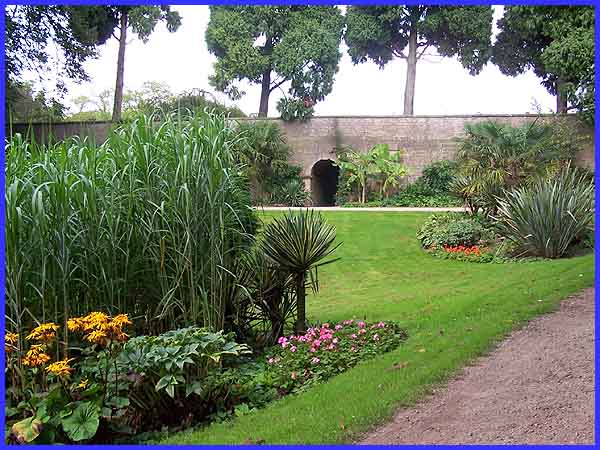
Before entering the gardens, we stood for a while talking to
a couple of guides who work at the Abbey and asked if there was
a particular route we should follow. They 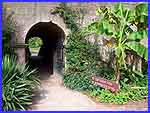 told us we could just 'wander anywhere
we liked' so following their advice we set off and followed our
noses towards the Garden Lake. Turning left by the Stew Pond
which possibly had its origin in a monastic fishpond we walked
by the yew trees into the Sub-Tropical Garden. It is probably
worth while at this point looking at this page (opens in a new window) to follow
our route through the gardens. Plants in the Sub-Tropical Garden
include bamboo, eucalyptus, pampas grass, plumbago, blue veronicas,
mahonia and yucca - just don't ask me to identify them! At this
point we noticed a short passage through the wall with a sign
pointing to the Eagle Pond and Boatswain's Tomb. told us we could just 'wander anywhere
we liked' so following their advice we set off and followed our
noses towards the Garden Lake. Turning left by the Stew Pond
which possibly had its origin in a monastic fishpond we walked
by the yew trees into the Sub-Tropical Garden. It is probably
worth while at this point looking at this page (opens in a new window) to follow
our route through the gardens. Plants in the Sub-Tropical Garden
include bamboo, eucalyptus, pampas grass, plumbago, blue veronicas,
mahonia and yucca - just don't ask me to identify them! At this
point we noticed a short passage through the wall with a sign
pointing to the Eagle Pond and Boatswain's Tomb.
|
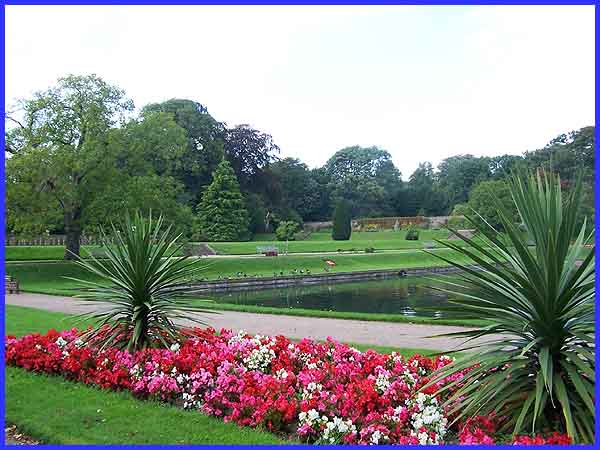
'Eagle Pond' by today's logic seems a misnomer on two counts
- the lack of eagles and the formal rectangular shape - but both
parts of the name have their origins in history. It is also known
as Mirror Pond but the 'Eagle' part of the name is derived from
the priory's eagle-shaped lectern that is said to have been hidden
here at the time of the Dissolution of the Monasteries. The 'Pond'
part comes from its probable mediaeval origin as a monastic fish
pond. Today the Eagle Pond lies at the centre of the walled and
terraced Great Garden to the east of the house and it is Canada
Geese that predominate all around it.
|
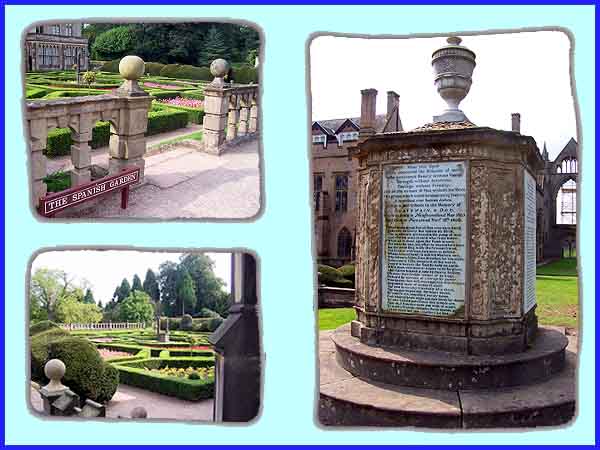
We walked round the pond and made our way to the maze-like Spanish
Garden which is on the site of the monastic burial ground. The
garden takes its name from the well head at the centre which
was copied from a Spanish original. On our way to the Spanish
Garden we had passed the poet Byron's monument to his dog Boatswain,
who died of rabies in 1808. The monument stands above a tomb
and on the spot where Byron mistakenly believed the High Altar
of the priory church to have stood. Byron's intentions were for
himself and Boatswain to be buried in the tomb but following
the sale of Newstead Abbey this became increasingly unlikely
to happen and Byron was eventually buried in the family vault
in nearby Hucknall. What became of Boatswain's remains is unknown
but they are no longer in the tomb although the monument is still
inscribed with Byron's tribute to his favourite dog.
|
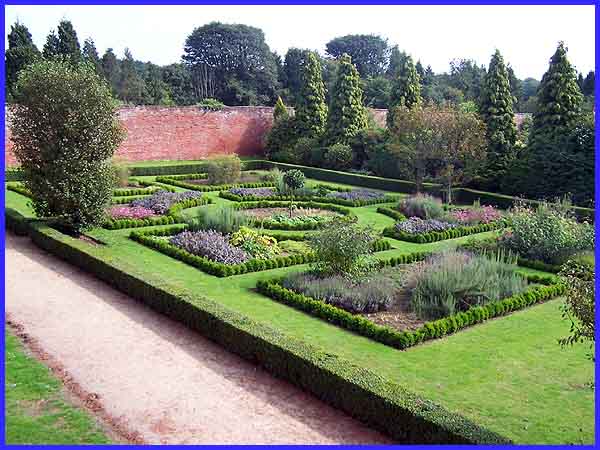
Continuing around the terrace from the Spanish Garden, we were
able to overlook the Small Walled Garden. This was originally
part of the Kitchen Garden built pre-1850 but before the turn
of the century it had been made into a rose and carnation garden.
It has undergone several changes since then being described in
1916 as a rose garden and in the 1960s it was transformed into
an iris garden. These too have now been replaced with a variety
of plants.
|
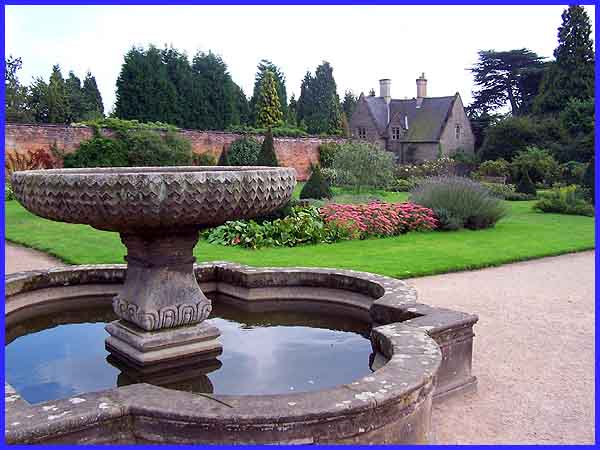
Next to the Small Walled Garden on the site of the Victorian
kitchen garden is another walled garden known as the Rose Garden
which was first set out as such as recently as 1965. In late
September 2006, roses were few and far between but there were
plenty of other flowers and plants to be seen and enjoyed. The
Gardener's Cottage that stands in the southeast corner of the
Rose Garden was built in the 1860s.
|
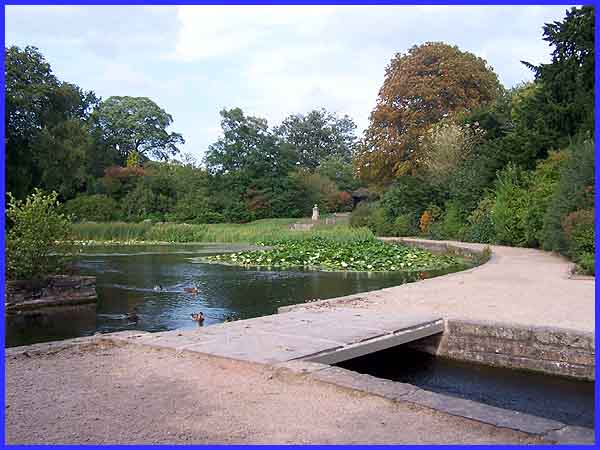
We made our way between the Fernery and the American Garden to
the Garden Lake, created by Thomas Wildman about 1820. Strategically
placed seats allow visitors to enjoy the vistas across the lake
whilst trying to identify some of the aquatic species that are
listed on the official website. These include yellow water lily,
wild angelica, water figwort, water forget-me-not, bittersweet,
corn mint, bulrush, brooklime, lesser pond sedge, soft rush,
toad rush, marsh marigold and water mint. Waterfowl such as ruddy
ducks, grey herons and kingfishers are also listed together with
dragonflies and damselflies. All in all it's just a lovely place
to enjoy nature.
|
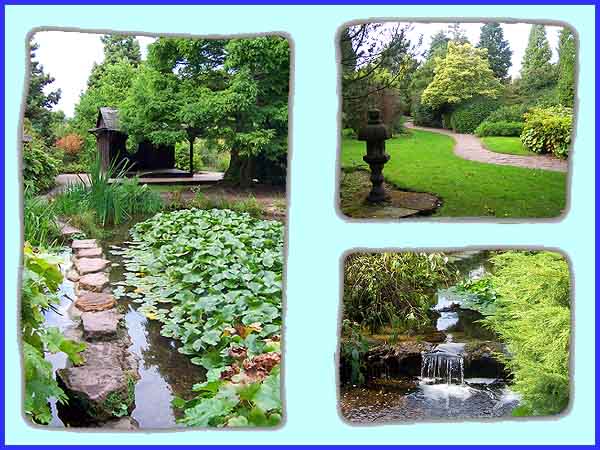
Water from an outlet in the lake flows into the Japanese Garden
which is recognised as one of the finest examples in Britain.
This is probably not surprising as it was laid out in 1899 by
a Japanese horticulturist brought to England specifically for
this task. Work to create the garden continued for another fifteen
years until the outbreak of the First World War but today it
has matured with stone lanterns, a teahouse and small stone bridges
and stepping stones linking islands across trickling streams,
into a splendid example of the archetypical Japanese Garden.
|
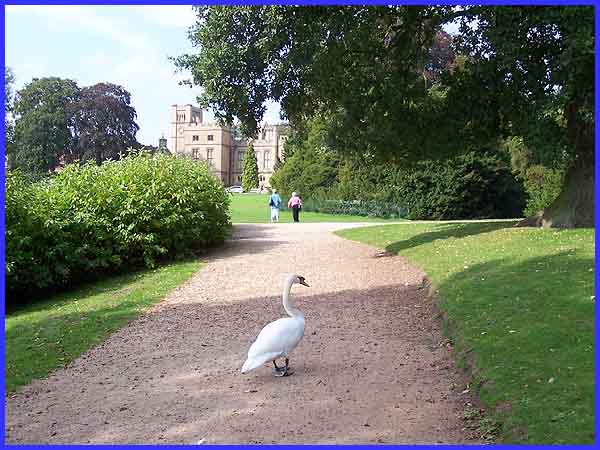
We left the Japanese Garden to follow the path around the Garden
Lake and in the steps of a swan back to the house. It was only
when we were back at home and had time to consult the map that
we realised there were several more areas that we could have
explored including the Monk's Garden and the French Garden not
to mention the stump of Byron's Oak - but that's something to
look forward to on our next visit.
Back to Paet 01
I wrote in the introduction to the Monk's Way, 'Other web sites already cover
Newstead in some detail' so if this has whetted your appetite
you can learn more at the official Newstead Abbey website or at Time Travel-Britain.
|



 told us we could just 'wander anywhere
we liked' so following their advice we set off and followed our
noses towards the Garden Lake. Turning left by the Stew Pond
which possibly had its origin in a monastic fishpond we walked
by the yew trees into the Sub-Tropical Garden. It is probably
worth while at this point looking at
told us we could just 'wander anywhere
we liked' so following their advice we set off and followed our
noses towards the Garden Lake. Turning left by the Stew Pond
which possibly had its origin in a monastic fishpond we walked
by the yew trees into the Sub-Tropical Garden. It is probably
worth while at this point looking at 





